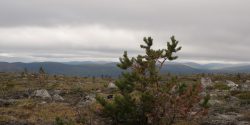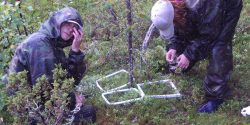Past research
The stress-gradient hypothesis predicts that the importance of facilitation relative to competition should increase with increasing stress. From 2001–2009, we conducted an integrated study of plant-plant interactions along three environmental gradients (elevation, pollution and seashore). Our subjects were woody plants, primarily mountain birch, Scots pine, Norway spruce and dwarf shrubs. We explored plant growth, reproduction and mycorrhizal colonization in the absence and in the presence of neighbours (either the same or other species). We found partial support for the stress-gradient hypothesis and for its generality in harsh subarctic environments, as the observed patterns differ between stress gradients and between several fitness-related variables.
Ongoing research
We have discontinued our studies of facilitation in plant communities, pursuing instead an exploration of the impacts of background insect herbivory on competition between co-occurring species of forest-forming trees.
Featured publications
Ruotsalainen, A. L., Markkola, A. & Kozlov, M. V. (2009) Mycorrhizal colonisation of mountain birch (Betula pubescens subsp. czerepanovii) along three environmental gradients: Does life in harsh environment alter plant-fungi relationships? Environmental Monitoring and Assessment, 148, 215-232 (doi: 10.1007/s10661-007-0152-y).
We investigated ectomycorrhizal communities (ECM) on roots of mountain birch along three environmental gradients, two natural (altitude, seashore) and one human-induced (pollution), within the Kola Peninsula, NW Russia. Although neither overall ECM colonisation nor root fungal biomass showed stress-related patterns, colonisation by Cenococcum geophilum tended to decrease with abiotic stress. We found that at high stress sites mechanical shelter created by polycormic trees may favour ECM fungi and mountain birches maintain lower ECM diversity than at low stress sites.
Eränen, J. K. & Kozlov, M. V. (2008) Increasing intraspecific facilitation in exposed environments: consistent results from mountain birch populations in two subarctic stress gradients. Oikos, 117, 1569-1577 (doi: 10.1111/j.0030-1299.2008.16772.x).
To test the hypothesis that the importance of facilitation relative to competition increases with increasing stress, we conducted field experiments with mountain birch seedlings and mature trees in two subarctic stress gradients (elevation and seashore). Three out of four performance variables indicated stronger positive host–seedling effects in the high stress sites. In seedling–seedling interactions competition dominated, but the effects were weak. We concluded that facilitation might dominate when the benefactor is substantially larger than the beneficiary, while competition may be stronger when the plants are of similar size and developmental status.
Zvereva, E. L. & Kozlov, M. V. (2007) Facilitation of bilberry by mountain birch in habitat severely disturbed by pollution: importance of sheltering. Environmental and Experimental Botany, 60, 170-176 (doi: 10.1016/j.envexpbot.2006.10.005).
We tested the hypothesis that positive effects of top-canopy plants on dwarf shrubs observed in industrial barrens were due to mechanical sheltering. Sheltering by wooden fence during 2 years improved performance and alleviated stress in bilberry plants growing in open microsites. Removal of natural shelter, i.e. cutting of neighbouring birch, caused steady decline in vegetative biomass production. We suggest that in harsh environmental conditions positive plant–plant interactions are primarily mediated by changes in biophysical environment, i.e. by protection from wind and extreme soil temperatures.
Zvereva, E. L. & Kozlov, M. V. (2004) Facilitative effects of top-canopy plants on four dwarf shrub species in habitats severely disturbed by pollution. Journalof Ecology, 92, 288-296 (doi: 10.1111/j.0022-0477.2004.00854.x).
We tested the hypothesis that the role of positive plant–plant interactions will increase with the environmental stress imposed by long-term pollution by comparing growth and reproduction of four dwarf shrub species under trees and in gaps in industrial barrens and in unpolluted forests in the Kola Peninsula, northwestern Russia. We found that the impact of top-canopy plants on dwarf shrubs shifted from negative in forest habitats to generally positive in barren habitats
Co-authors
O. Grau
J. Eränen
P. Rautio
J. Heikkinen
A. Markkola
A. Ruotsalainen
K. Saravesi
E. Zvereva

